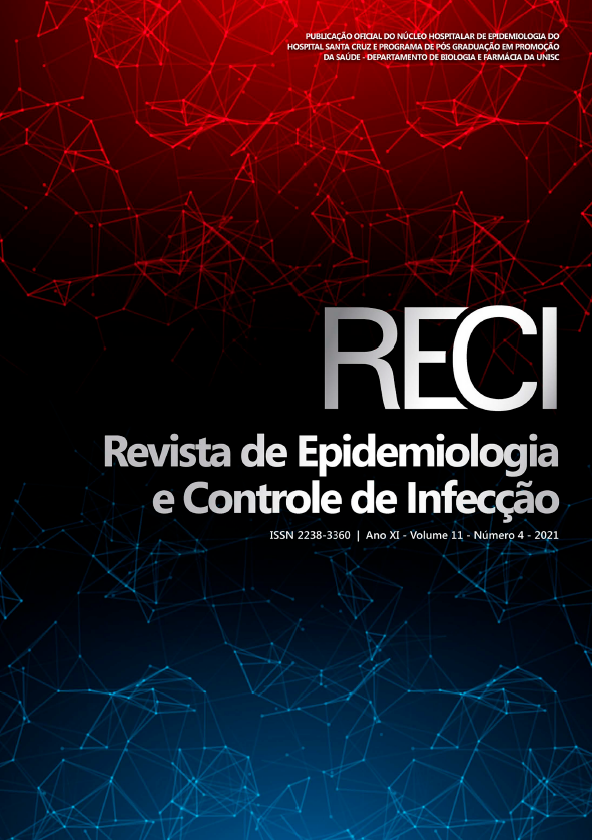Implementación de un bundle para la prevención de la neumonía asociada al ventilador en un hospital universitário
DOI:
https://doi.org/10.17058/reci.v11i4.16334Keywords:
Pneumonia Associada a Ventilação Mecânica. Unidade de Terapia Intensiva. Prevenção. Segurança do PacienteAbstract
Background and objectives: the implementation of ventilator-associated pneumonia (VAP) prevention bundles in Intensive Care Units (ICU) has been recommended due to the considerable increase in hospital costs, length of stay, morbidity and mortality in affected hospitalized patients. However, the results of its effectiveness are still controversial. This study aimed to assess the impact of implementing a VAP prevention bundle in an Adult ICU of a university hospital. Methods: a quasi-experimental study, with implementation of a VAP prevention bundle in an Adult ICU and analysis of indicators. This study addressed secondary data from hospital records recommended in the routine of the Hospital Infection Control Commission team and from the medical records of patients undergoing mechanical ventilation, from June 2016 to July 2019, who developed VAP. Results: VAP incidence density before the intervention was 4.13 infections, and after the intervention, it was 7.15 infections per thousand patients on ventilation/day. When performing the linear regression test, we showed that VAP density decreased as sedation was reduced, extubation was increased, and when compliance with all bundle elements occurred. Conclusion: there was no reduction in VAP incidence after the adoption of preventive measures, perhaps due to an underreporting of cases in the period prior to the bundle and a low team compliance with the bundle components. However, we noticed a decrease in VAP notifications after the eighth month of implementation of bundle of measures.
Downloads
References
Agência Nacional de Vigilância Sanitária (BR). Medidas de prevenção de infecção relacionada à assistência à saúde. Brasília: Anvisa; 2017.
Ding S, Kilickaya O, Senkal S, et al. Temporal Trends of Ventilator-Associated Pneumonia Incidence and the Effect of Implementing Health-care Bundles in a Suburban Community. Chest. 2013;144,5. http://dx.doi.org/10.1378/chest.12-1675
Barbas CSV, Couto LP. Tubos endotraqueais com aspiração suprabalonete diminuem da taxa de pneumonia associada à ventilação mecânica e são custo-efetivos? Rev Bras Ter Intensiva. 2012; 24(4): 320-321. https://www.scielo.br/pdf/rbti/v24n4/a04v24n4
Bickenbach J, Marx G. Diagnosis of pneumonia in mechanically ventilated patients: what is the meaning of the CPIS? Minerva anestesiologica. 2013; vol. 79, n.12.https://www.minervamedica.it/en/journals/minerva-anestesiologica/article.php?cod=R02Y2013N12A1406
Chouhdari A, Shokouhi S, Bashar FR, et al. Is a Low Incidence Rate of Ventilation Associated Pneumonia Associated with Lower Mortality? a Descriptive Longitudinal Study in Iran. Tanaffos. 2018; 17(2): 110-116. https://www.ncbi.nlm.nih.gov/pmc/articles/PMC6320555/
Righi E, Aggazzotti G, Ferrari E, et al. Trends in ventilator-associated pneumonia: Impact of a ventilator care bundle in an Italian tertiary care hospital intensive care unit. American Journal of Infection Control. 2014;1312-6. http://dx.doi.org/10.1016/j.ajic.2014.08.009
Agência Nacional de Vigilância Sanitária (BR). Critérios Diagnósticos de Infecção relacionada à Assistência à Saúde. Brasília: Anvisa; 2017.
Carvalho CRR. Pneumonia associada à ventilação mecânica. J Bras Pneumol. 2006; 32(4): 10-12. http://dx.doi.org/10.1590/51806-371320060000400003
Klompas M, Lingling L, Kleinman K, et al. Associations Between Ventilator Bundle Components and Outcomes. JAMA Intern Med 2016; 176(9):1277-1283. http://dx.doi.org/10.1001/jamainternmed.2016.2427
Wolfensberger A, Meier MT, Clack L, et al. Preventing ventilator-associated pneumonia- a mixed-method study to find behavioral leverage for better protocol adherence. Infection Control e Hospital Epidemiology. 2018, 39, 1222-1229. http://dx.doi.org/10.1017/ice.2018.195
Lourençone EMS, Branco A, Monteiro AB, et al. Adesão às medidas preventivas versus incidência de pneumonia associada à ventilação mecânica. Rev Epidemiol Controle Infecç. 2019 abr-junh:9(2):142-148. http://dx.doi.org/1017058/reci.v9i2.12596
Jadot L, Huyghens L, De Jaeger A, et al. Impact of a VAP bundle in Belgian intensive care units. Ann Intensive Care. 2018: 8,65. http://dx.doi.org/101186/s13613-018-0412-8
Schreiber PW, Sax H, Wolfensberger A, et al. The preventable proportion of healthcare-associated infections 2005-2016: Systematic review and meta-analysis. Infection Control e Hospital Epidemiology. 2018; 0, 1-19. http://dx.doi.org/10.1017/ice.2018.183
Reper P, Dicker D, Damas P, et al. Improving the quality of the intensive care follow-up of ventilated patients during a national registration program. Public Health. 2017; Vol 148, 159-166. http://dx.doi.org/10.1016/j.puhe.2017.03.014
Beattiea M, Shepherd A, Maher S, et al. Continual improvement in ventilator acquired pneumonia bundle compliance: A retrospective case matched review. Intensive and critical care nursing. 2012;28,255-262. http://dx.doi.org/10.1016/j.ccn.2012.01.007
Rodrigues AN, Fragoso LVC, Beserra, FM, et al. Impactos e fatores determinantes no bundle de pneumonia associada à ventilação mecânica. Rev Bras Enferm. 2016; 69 n.6. http://dx.doi.org/10.1590/0034-7167-2016-0253
De Luca LA, Walsh P, Davidson DD, et al. Impact and feasibility of an emergency department–based ventilator associated pneumonia bundle for patients intubated in an academic emergency department. America Journal of Infection Control. 2017;45,151-157. http://dx.doi.org/10.1016/j.ajic.2016.05.037
Ego A, Preiser JC, Vicent JL. Impact of Diagnostic Criteria on the Incidence of Ventilator-Associated Pneumonia. Chest. 2015; 147:347-355. http://dx.doi.org/10.1378/chest.14-0610
Klompas M. What is new in the prevention of nosocomial pneumonia in the ICU? Critical care. 2017;23, n. 5. http://dx.doi.org/10.1097/MCC.0000000000000443
Alvarez -Lerma F, Palomar-Matinez M, Sanchez-Garcia M, et al. Prevention of Ventilator-Associated Pneumonia: The Multimodal Approach of the Spanish ICU “Pneumonia Zero” Program. Crit Care Med. 2018;46:181-8. http://dx.doi.org/10.1097/CCM.0000000000002736
Eom JS, Lee MSL, Chun HK, et al. The impact of a ventilator bundle on preventing ventilator-associated pneumonia: A multicenter study. American Journal of Infection Control. 2014;42,34-37. http://dx.doi.org/10.1016/j.ajic.2013.06.023
Rello J, Afonso E, Lisboa T, et al. A care bundle approach for prevention of ventilator-associated pneumonia. Clinical Microbiology and Infection. 2013;19, n4. http://dx.doi.org/10.1111/j.1469-0691.2012.03808
Caroff D, Li L, Muscedere J, et al. Subglottic secretion drainage and objective outcomes: a systematic review and meta-analysis. Crit Care Med. 2016;44: 830-40. http://dx.doi.org/10.1097/CCM.0000000000001414
Downloads
Published
How to Cite
Issue
Section
License
Copyright (c) 2022 Taciane Cristina Santana, Luciana Paiva, Cristina da Cunha Hueb Barata de Oliveira

This work is licensed under a Creative Commons Attribution 4.0 International License.
The author must state that the paper is original (has not been published previously), not infringing any copyright or other ownership right involving third parties. Once the paper is submitted, the Journal reserves the right to make normative changes, such as spelling and grammar, in order to maintain the language standard, but respecting the author’s style. The published papers become ownership of RECI, considering that all the opinions expressed by the authors are their responsibility. Because we are an open access journal, we allow free use of articles in educational and scientific applications provided the source is cited under the Creative Commons CC-BY license.


